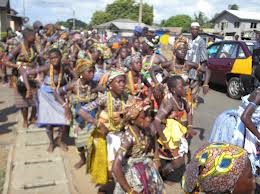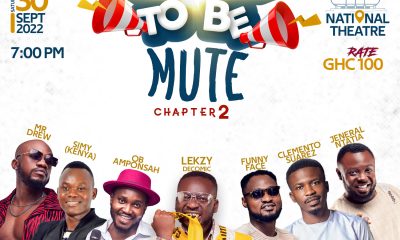Events
A profile of the Hogbetsotso festival
 The traditional drumming and dancing, cheering crowds, palanquins in different shapes and sizes and singing of traditional war songs, combine to make the Hogbetsotso festival a must-not-be-missed spectacle.
The traditional drumming and dancing, cheering crowds, palanquins in different shapes and sizes and singing of traditional war songs, combine to make the Hogbetsotso festival a must-not-be-missed spectacle.
October marks the beginning of the festive season that continues up to November.
Anloga, a town marked by a meandering lagoon and golden sand beaches overhanging the Atlantic ocean, is where the grand durbar is held on every first Saturday in November.
History of Hogbetsotso
Tracing the history of the festival, Agbotadua Kumassah, a traditional ruler and a historian, recounted that the Hogbetsotso was instituted to commemorate the exodus of the Ewes from Notsie to their present settlement in Ghana.
He explained that the term Hogbetsotso was derived from three Ewe words ‘Ho’ means to uproot or move, ‘Gbe’ means day and ‘tsotso’ meaning crossing over. So literally, Hogbetsotso means the day the people rose up and moved out of Notsie.
According to him, the Ewes at ‘Notsie’ were ruled by kings – both good and bad ones.
The most legendary of them all, he said, was King Agorkoli, the despot who ruled his people with an iron hand.
He said that at a point in time, the king ordered the Ewes to erect a security wall with a height of 24 by 18 feet round his Kingdom with clay which he mixed with hedgehogs, bristles, prickly thorns and broken pots.
He said when the Ewes realized that the wickedness of the king towards them had reached its peak; they resolved to escape from the walled city.
The women were, therefore, asked to empty all bath waters and any waste water against the wall to soften and desecrate it.
On the appointed night, the great wall was broken, and the people left walking and dancing backwards hilariously to the throbbing music of the ‘Adekpetsi’ and the ‘Husago’ dance to avoid detection.
The various Ewe groups moved out and made the final journey to their present locations in Ghana.
The ‘Husago’ Dance
Celebrating Hogbetsotso without the traditional Husago dance makes the festival incomplete.
According to Dr Datey Kumodzie, a Cultural Anthropologist, the Anlo Ewes, while escaping from Notsie, carried what was known as the 37 articles of life on a wooden tray with lighted lamps in the middle which was symbolically meant to convey a message to the wicked King Agorkoli that;
“we are the group of highly enlightened people who have mastered perfectly the problems of the universe and have come to settle here. If you want to know who we are, you must trace our footprint backwards but remember we have tried to wipe our footprint from the sand of time.”
Dr Kumordzie said the escapees while performing the backwards dance, tied two hens on their legs and dragged them in front of them as they escaped. As the hens spread their wings to fly, the feathers wiped away their footprints.
The whole drama of their miraculous escape from Notsie was similar to the experience of the Hebrews when they fled from Egyptian captivity and were led out by the mighty hand of Moses.
Amega Wenya led the group that journeyed south towards the sea. This group comprised the Anlo, Tsevie Ametiave, Be, Togo, Viepe, Ave, Fenyi, Dzodze and Flawu group, among others.
Upon reaching Atiteti near Wheta, they went through a narrow creek to Kedzi where Amega Wenya discovered a full stretch of coastland with golden sand.
He then proclaimed: “We are on the sand” hence the name Kedzi. Later, he named Keta that he called the ‘head of the sand.”
When Wenya and his group reached Anloga, he made a famous statement: “Menlo”, which literary means “I have coiled.”
This proclamation became the generic name of the Anlo State he founded.
Significance of the festival
Hogbetsotso reminds the Anlos of their ancestry. It rekindles the bond of relationship that existed between them and other Ewe-speaking people and also affords the citizens the opportunity to appraise their development programmes in the past year.
The festival is an occasion when the whole of Anlo is open to visitors and where the full cultural value of the people is put on display.
Rituals preceding the festival
One of the most significant rituals that precede the Hogbetsotso festival is a state divination which is performed by distinguished seers selected from major towns throughout the 36 Anlo states.
Once the seers have announced the rituals that need to be carried out, the traditional priests perform the appropriate ceremony invoking the gods of the land.
After that, all the seers gather at Atiteti on the estuary of the Volta Lake to perform additional sacrifices.
Another important ritual is the state cleansing and sanitation programme known as ‘Dodede and Apekplorkplor’ which is also performed by recognized seers.
On the last Thursday before the day of the durbar, the ritual performed is aimed at social reconciliation.
This activity is aimed at reconciling individuals and groups within the 36 Anlo states.
source:
graphiconline.com















